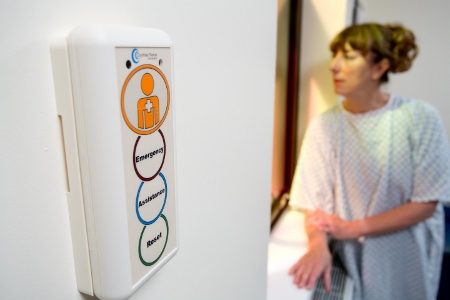The problem
The UK’s hospitals are admitting increasing numbers of elderly patients with dementia and the Government’s £50m dementia care pot recognises the urgent need to address this trend with specialist care and facilities.
Warrington Hospital successfully bid for a £1m share of that £50m through the King’s Fund to refurbish a former 24-bed elderly care ward into a custom-designed dementia unit that addresses patients’ physical, mental and emotional needs.
Practical considerations
Warrington Hospital began by forming a consultation group to aid design and specification of the Forget-Me-Not unit. The group was made up of patient/carer representatives, members of the estates team, clinical professionals and representatives from the Alzheimer’s Society to ensure that both practical and social considerations were incorporated.
Our approach has been to prioritise comfort, safety and high standards of care in an environment that helps patients to feel at home by engaging with their long-term, functioning memory while providing strategies for addressing their lack of short-term recall
Among the practical elements, the nurse call system was critical, ensuring not only that patients can call for prompt assistance, but also that a degree of flexibility is built into the unit.
Explains Lee Bushell from the hospital’s estates capital projects team: “We had been upgrading the hospital to Courtney-Thorne’s 08 wireless nurse call system on a rolling programme of ward refurbishments since 2012, so we knew we could be confident that it would be reliable.
“We also needed a system that was both flexible and scalable should we need to reconfigure or extend the unit in the future and the wireless system means that we can make changes without any rewiring.”
The unit accommodates 17 patients across one seven-bed bay and two five-bed bays, each of which are served by their own nursing station. Each nursing station has a dedicated touchscreen to display and monitor calls from patient beds, the dining and social areas on the unit and the sensory garden, which has been created to encourage patients to spend time outdoors. The system also provides real-time management information, enabling the hospital’s team to track call patterns and analyse response rates.
Bushell said: “Any hospital ward needs to use management information to monitor standards of care and plan staffing levels, but in a dementia unit that’s particularly important because staff ratios need to be higher and patients often become disoriented and may complain that nurses have taken too long to respond.
“The data recorded by the Courtney-Thorne system ensures we have accurate information about response rates, helping us reassure relatives about the standard of care.”
A relaxing environment
The standard of care is exceptionally high, thanks in no small part to the custom-designed dementia environment. Every element of the layout and decoration has been designed to reduce patient anxiety and disorientation while encouraging social interaction, independence and stimulation.
Colour plays a pivotal role, with colour-coded doors and door frames to help patients identify different areas, such as toilets, and neutral-coloured doors to staff only areas to deter patients from straying into these locations.
Any hospital ward needs to use management information to monitor standards of care and plan staffing levels, but in a dementia unit that’s particularly important because staff ratios need to be higher and patients often become disoriented and may complain that nurses have taken too long to respond
Pictures are also a noticeable feature, with picturegrams to aid wayfinding, a cartoon-style mural of the local area to help patients tap into long-term memory, and a bus stop where they can sit and chat.
Bushell said: “We found that dementia patients often ‘want to go home’ and the bus stop provides an area where they can go and sit to ‘wait for the bus’. Any member of staff that sees a patient sitting alone at the bus stop will chat to them and reassure them and many patients like to use it as a social area too.”
Other social areas include the dining room and a quiet room where an old-style TV screen shows images of local scenes from the 1950s and 1960s.
“Our approach has been to prioritise comfort, safety and high standards of care in an environment that helps patients to feel at home by engaging with their long-term, functioning memory while providing strategies for addressing their lack of short-term recall,” said Bushell

A new nurse call system is central to the revamped ward

